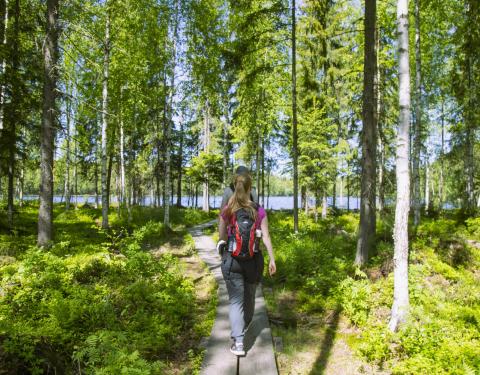Preparedness and adaptation to climate change

The impacts of climate change are already visible in Tampere and are expected to intensify in the future. While reducing climate emissions remains top priority, it is also crucial to anticipate and adapt to changes in environmental conditions.
How does climate change affect Tampere?
According to the expert report, the most significant risks caused by climate change in Tampere are:
- risks related to water and water management; heavy rainfall, pluvial and fluvial floods
- periods of hot weather and drought
- storms
- biological risks
- diseases and pests
- ecosystem changes (changes in species and alien species, loss of biodiversity).
As the city continues to expand and become more condensed, it becomes increasingly vulnerable to factors such as heat and heavy rain. At the same time, the need for being prepared and responsive to the impacts of climate change increases. Stormwater floods and heat waves pose a particular challenge to the Tampere city centre area. On the other hand, areas dominated by agriculture and forestry in northern Tampere are more prone to being affected by extreme weather such as storms and droughts.
The urban population most at risk from severe weather includes small children, the elderly and persons with a general impairment in functional capacity or reduced mobility, as well as people with low income, homeless people and those belonging to linguistic minorities. The so-called climate risks are evaluated by considering the vulnerability of people to the effects of storms, slippery conditions and heat, and by estimating how well they can adapt to emergency conditions. For example, for the elderly or those moving with assistive devices, excessive snowfall and a heightened risk of slippery roads may mean less outdoor activity and staying at home.
Preparedness and adaptation to climate change prevent harmful effects
Adaptation to climate change refers to the capacity of both humans and natural systems to adjust and prepare themselves for the changing environmental conditions and changes in the climate. Adaptation measures include managing increasing rainfall in retention basins, or modifying road maintenance procedures to correspond with the changed road conditions.
The goal of the adaptation measures is to mitigate the negative impacts of climate change, such as storms and hot weather, and to benefit from potential advantages, such as the prolongation of the growing season. The sooner we adapt and prepare, the less uncontrolled damage there will be. The later our wake-up call, the greater the expense, both in terms of finances and humanity.
To effectively combat climate change, it is crucial for all sectors of the city to cooperate and for residents and companies to play an active role. The changing climate and its impacts must be taken into account in urban planning and construction as well as in the development of social and health care services. Parks, green spaces, roadside verges and other parts of the city’s green structure play a particularly significant role, as they contribute to stormwater management and heat protection.
The city has long been implementing a wide range of adaptation measures, but in 2022, these measures were brought together and organised in a centrally coordinated manner. The resulting summary report lays the foundation for adaptation and preparedness in the city. The city makes preparations and adjusts to climate change in interaction with the city’s risk management; the likelihood and severity of risks are determined, along with the plan for risk mitigation.
The key objectives and actions of Tampere’s climate work, including climate change mitigation, have been compiled in the Climate Neutral Tampere 2030 Roadmap. The roadmap is updated every two years. Each service area is responsible for the actions presented in the roadmap, and the updating process is coordinated by the Climate and Environment Unit. The implementation of the measures is monitored using the Tampere Climate and Environment Guard.
Tampere's Climate and Environment Guard
Follow the city's actions to adapt to and prepare for climate change in the Climate and Environment Guard.

Biodiversity Programme 2021–2030
Climate change and biodiversity loss are part of the same crisis. The city’s biodiversity efforts have been compiled in the Tampere Biodiversity Programme (LUMO programme). You can also track the biodiversity efforts in the Climate and Environment Guard.
